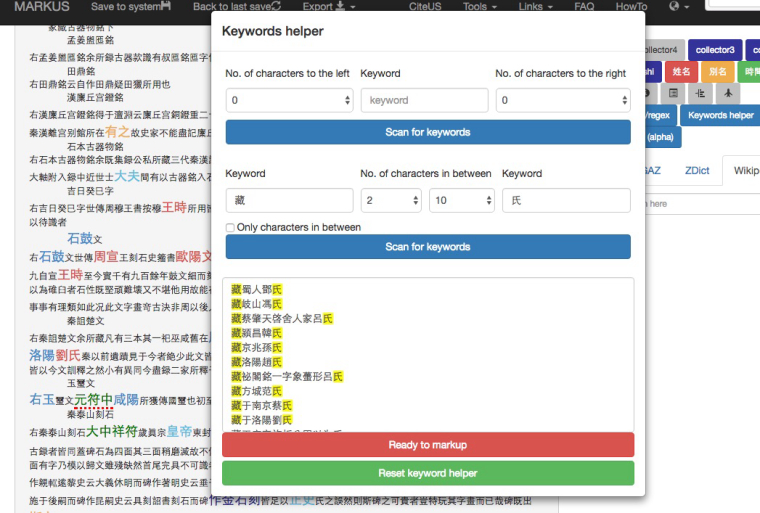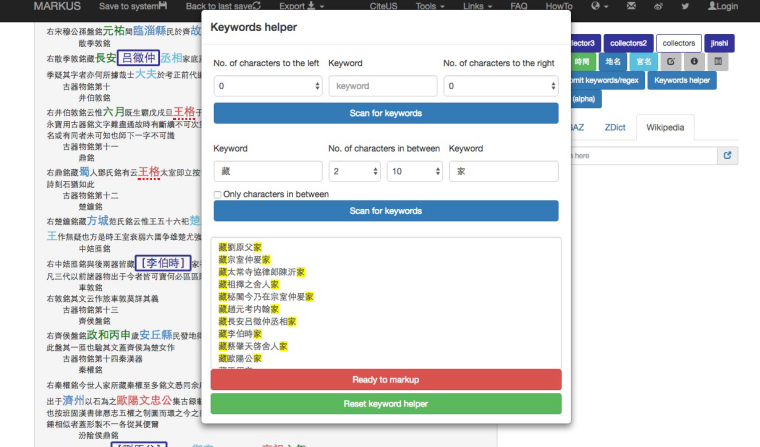The Song cultural elite were the first to develop an intense interest in collecting and studying ancient ritual bronze objects from the “Three Dynasties.” Several of the art catalogues and commentaries they compiled, some with illustrations, survive to this date. These antiquarian works provide information about the collectors, the items they collected, and their thoughts about antiquities. Moreover, these authors often referred to their predecessors from one or two generations before them and recorded their interactions with contemporary collectors and connoisseurs. The antiquarian works shed light on not only the Song elite’s study of antiquities but also their social relations with other collectors. With the aid of MARKUS and CBDB, my goal is to reconstruct the collecting circles for each of the antiquarian works, which will serve as a foundation for further analysis.
Here, I am using Jinshi lu 金石錄* by Zhao Mingcheng 趙明誠 (1081–1129) as an example to demonstrate how to extract information using MARKUS, how to process that information, and finally, the problems I encountered. What I show here is part of an ongoing experiment, and I welcome any comments and suggestions.
I. Extracting information
For each of the antiquarian works, I created Excel spreadsheets containing data of the collected items, collectors, and provenance by manually inputting information from earlier research. MARKUS might be useful in double-checking the missing data, particularly for the collectors mentioned in Jinshi lu, because Zhao Mingcheng used formulaic phrases when referring to the collectors: 藏…氏 and 藏…家. With “Keywords helper” in the Keyword function, the lists of collectors’ names were extracted instantaneously, as demonstrated in the following images.
Step 1: Keywords helper “藏…氏”

Step 2: Keywords helper “藏…家”

The results from Step 1 and 2 have high relevancy, as shown in the two previous screenshots.
Step 3: Keywords helper “舊藏…家”
Zhao Mingcheng occasionally revealed the transmission of antiquities by using the term舊藏 to record the names of former collectors. Running the Keywords helper again with “舊藏…家” allowed me to identify the earlier collectors from the results of Steps 1 and 2.

With Keywords helper, I could identify two missing collectors and thereby make my dataset more complete. In the case of Jinshi lu, although MARKUS was extremely effective in extracting collectors’ names, as previously demonstrated, when applying the keywords in the lists to mark up the text, a problem occurred. The application did not tag those terms that had automatic location markups, such as 方城范氏. MARKUS does not allow adding multiple tags to a term.
II. Processing the data
With the names of the collectors and connoisseurs found and extracted, the next step was to find their social relations in CBDB, import the association data to Gephi, and produce a social network graph of Zhao Mingcheng on the basis of the records in Jinshi lu, as shown in the following image. For greater legibility, the nodes with only 1 edge are purposely hidden. The bold, weighted lines are associations extracted from Jinshi lu, whereas the thin lines are social associations collected from CBDB.

Total: Nodes: 388; Edges: 443
After filtering out the nodes with only 1 edge: Nodes: 42 (10.82% Visible); Edges: 97 (21.9% Visible)
The juxtaposition of the association from Jinshi lu with other types of associations from CBDB allows us to explore and understand how the collectors related to one another in a larger social context. Some nodes are noticeable in the graph. Looking at the centrality values generated by Gephi is also helpful in identifying people of greater influence in the network. For instance, the betweenness centrality that quantifies the bridging capability of the nodes indicates Zhao Mingcheng, Chao Buzhi 晁補之, Liu Qi 劉跂, and Mi Fu 米芾 as the most pronounced communicators in the network. The reason for this is certainly worthy of further investigation.
The same approach was applied to four other antiquarian works of the Northern Song to generate network graphs for each work. Comparing these network graphs allows for an assessment of their relative scale and complexity, and taking the temporal dimension into consideration further affords a delineation of the long-term development of the collecting circles. Through the visualization of the social networks, I could observe how the circles related to one another and how the shape of the overall picture changed over time. As an historian and art historian working primarily with illustrated books and objects, I have not used the markup function of MARKUS extensively. But MARKUS is a versatile tool, with excellent Keyword functions for extracting information. MARKUS could also be a useful tool for students who want to read texts in classical Chinese. With various built-in dictionaries, one can read and understand the text more efficiently. In conclusion, what is presented here is a work-in-progress project. Comments and suggestions are welcome.
- The editions used in this study are:
- 趙明誠,《宋本金石錄》,北京:中華書局,1991。
- 趙明誠著,金文明校證,《金石錄校證》,桂林:廣西師範大學出版社,2005。
Ya-hwei Hsu, Assistant Professor, National Taiwan University